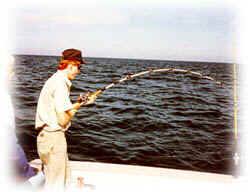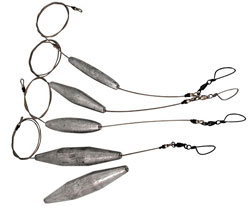
Several of the Suncoast's most popular gamefish are found at many different depths. Some species travel up and down the water column many times in the course of a day. Consistently putting a bait in front of these fish means being able to fish as much of the water column as possible. If you just
want to fish a foot or two below the surface, then there are many lures you can have in your arsenal. These are designed with lips made of plastic or stainless that will work fairly shallow - up to depths approaching fifteen feet or so. Check with your tackle store or the manufacturer for the specifications of the lure that you are considering.
Weighing the options
Let's say you have a favorite lure without a lip or live bait that you want to fish a few feet further down in the water column. Maybe the water is too rough for the lure to "dig in" and stay underwater. What to do? Perhaps a trolling lead will suffice. Trolling weights are torpedo-shaped sinkers with a ring at each end or wire with swivels so that you may tie your running line to one end and your leader to the other. I have seen them in weights of one ounce up to as much as eight ounces. There are larger ones for special applications, but remember - the more weight on your line ahead of the lure, the more difficult the fight with a running fish.
a ring at each end or wire with swivels so that you may tie your running line to one end and your leader to the other. I have seen them in weights of one ounce up to as much as eight ounces. There are larger ones for special applications, but remember - the more weight on your line ahead of the lure, the more difficult the fight with a running fish.
Another possibility, if you have the money, is wire line fishing. Wire line is just what it sounds like. The line on your reel is made from stainless steel or Monel, which is a form of stainless that will not rust. This line is very expensive to use as it must be replaced on a regular basis. If the line kinks, it will break, and you cannot really splice it together. The rod guides must be of a type that will not be cut by the wire as it is let out and reeled in. Usually the reel is a Penn 4/0 that must be repaired or replaced with regularity because of the stresses that the wire line causes. It is my suggestion that you leave wire line fishing to the pros. If you have to try it, be sure you find a tackle shop in your area that is familiar with the special rigs that you will need. It is doubtful that your local discount store will be able to help you.
What about downriggers?

Another relatively expensive option, at least in the initial outlay, is a downrigger. A downrigger is usually mounted on the gunwale of your boat or in a rod holder (reinforced from below). It has a large reel holding either stainless cable or heavy monofilament. attached to a boom from two to four feet long. The cable on the reel runs through a pulley on the end of the boom and a weight is attached at the end. The most common weight is a ten pound lead ball, but there are several weights and shapes that you can get - even a plastic "wing" that works instead of the weight. The object, of course, is to lower this weight to the depth that you wish to troll with your  fishing line attached to either the weight or the line with a special release clip.
fishing line attached to either the weight or the line with a special release clip.
Downriggers are very effective and you can run more than one line from a downrigger with stacking clips, but they are also space-hogs on a small boat. Before purchasing a downrigger, you should strongly consider the space on the boat that you will lose. You will need somewhere to store the downriggers when they're not in use, and they take up space on the gunwale that you will need while fighting a big fish.
An economical alternative
For those people that do not own downriggers, deep planers have been very economical mainstays in tackle boxes for more years than I know. There are many sizes of planers, from very small, 1-2 inches long, to the larger ones that are up to ten inches long. They are made in many shapes - rectangular, round or oval, and from both plastic and stainless steel. The use of the planers, of course, is to take your bait or lure deeper in the water column than they would run normally. You can have many different sizes of planers on your boat all the time. They take up very little space and they are very easy to rig quickly if you perceive the need to go deeper with your bait. Because the various sizes put different stresses on your tackle and will pull various lures, you need to evaluate what your needs are before rushing out to purchase a bunch of planers.
If you are fishing light tackle only, then planers will probably not suit your style of  fishing. There may be some smaller, light weight planers that I haven't seen, but usually the lightest weight suitable for the weight and stresses would be in the twenty pound range. You will find as you increase the size of the planers that you will need to increase the size of the tackle that you are using as well. When I pull a number one or two planer, it is usually on forty pound test with rods to match. A number three and number four planer go on my eighty pound tackle. When I really want to go deep with a number five or larger, I have a special rig that is made for this type of fishing. (More on this in a minute.)
fishing. There may be some smaller, light weight planers that I haven't seen, but usually the lightest weight suitable for the weight and stresses would be in the twenty pound range. You will find as you increase the size of the planers that you will need to increase the size of the tackle that you are using as well. When I pull a number one or two planer, it is usually on forty pound test with rods to match. A number three and number four planer go on my eighty pound tackle. When I really want to go deep with a number five or larger, I have a special rig that is made for this type of fishing. (More on this in a minute.)
Another consideration with planers relates to the lure you're pulling - specifically, how big can its lip be? As you know, the deeper a lipped plug runs, the harder it pulls on your line. Each planer size will trip at different weight pulls on the line. If you are pulling only spoons or non-diving lures then you can use any size planer to take it to the various depths that the planers will run. A guestimate for the depths to expect are: #1 planer - three to five feet, #2 planer - four to ten feet, #3 planer - five to fifteen feet, #4 planer - ten to twenty-five feet, #5 planer - up to sixty or seventy feet.
Let's get back to the lip sizes on diving plugs. As you increase the lip size, you will find that you must also increase the planer size at some point because the pull of the lure trips your planer. Even the #5 planer will not pull some of the bigger lipped plugs that are being made today. Most plug colors and sizes are being made with various sized lips as well, so you shouldn't have any trouble finding your favorite color and size combination with smaller lips.
Rig 'em up
The diagram shows how the planer is set up to pull down your lure. When a fish hits it, the ring that your running line is attached to slides forward - this is called "tripping" the planer. Once the ring slides to the front, then the planer is in line with your fishing line and the lure, and since there is not much additional stress, the fish can be fought normally.

As for rigging the larger #5 and up planers, I have a friend that builds a special reel for me out of teak and stainless. It has handles - so that you can reel in the stainless cable that is attached to the planer without kinking it, or cutting your hands. The reason that we use stainless cable is that it will run deeper with less water resistance than monofilament of the same strength. We don't use a rod when fishing this large planer, but you could, if you wish, use a release clip on the back of the planer just like a downrigger does. You can then use any size tackle that you like.
I've used this method, and it works well, but I'm usually fishing for large grouper along very rough bottom when I use this rig. Because of this, I prefer to hand line them straight in with the cable. When the planer trips, it brings the fish to the surface, acting in just the opposite way as when it is diving and helps me with the job of bringing it in by hand.
The cable that I use on my #5's is stainless aircraft control cable, wound on a frame of stainless reinforced teak. It has handles to wind and unwind the cable and a rubber shock cord that attaches between the "winder" and a line tied to a boat cleat.
I hope this will help you determine what type of equipment to use to get your lures deeper in the water column. Deeper is where you need to be, because if you are not fishing the entire water column, then you're often losing opportunities to catch fish - particularly in offshore fishing.
Good fishing and tight lines,
Capt. Charlie
Back to Some Techniques for fishing in the Gulf


